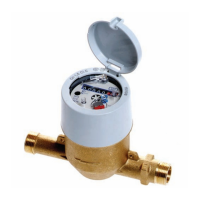LD1621INT Page 2
Accuracy
The development of a new material with a density
close to that of water and an enhanced quality of
surface finish results in a piston that glides easily
in the measuring chamber at very low flows. The
smallest leakage downstream of the meter can
therefore be registered.
The measuring range of the 620 meter is much
wider than class C requirements. With the approval
according the new MID regulation a Q3/Q1 ratio up
to 400 can be obtained that combines the precision
at both small and high flowrates.
Reliability
The exclusive composite material of the piston
of the 620 meter combine lightness and excellent
surface conditions. The piston can move in the
measuring chamber without friction and also with
very low wear.
Foreign matter present in water can be filtered
first by the tubular strainer, then by the seat
strainer. The smallest particles can go through the
meter without damage; the elastic pivot enables
the particles to pass between the piston and the
measuring box. In this case, the surface hardness of
the piston and the measuring box avoids scratches.
All the gears are situated in the dry part of the
meter (totalizer), which removes any risk of
blockage due to suspended matter in the water.
The 620 water meter keeps its metrological
accuracy for many years of operation, even in very
difficult working conditions.
Register
The display of 8 drums (5 for m3, 3 for litres) and
1 pointer ensures perfect readability. The lowest
resolution is 0.05 litres. The dial has a central disc
whose rotation indicates the passage of water. This
indicator can be used to reveal a downstream leak.
The plastic register is equipped with a wiper for
optimum legibility under all conditions. The 620
water meter can operate in any position and its dry
dial can rotate up to 350º. The dial can therefore be
easily read under all conditions of use.
When meters are installed in a very humid
environment (external pit for example) the 620
meter(*) can be supplied with a metal/glass register
giving the guarantee of index readibility.
Typical Accuracy Curve
Typical Pressure Drop Curve
Cross Section
Q
1
Q
2
Flow Q
3
Q
4
-15%
-10%
-5%
0%
5%
Accuracy(%)
Q
3
/R
1.6 Q
1
1.25 Q
3
DN 15
DN 20
DN 25-30
DN 40
Head loss (bar)
1
3 5 7 10 20
100
Flow (m
3
/h)
0.1
1.0
In-line version
Co-axial version

